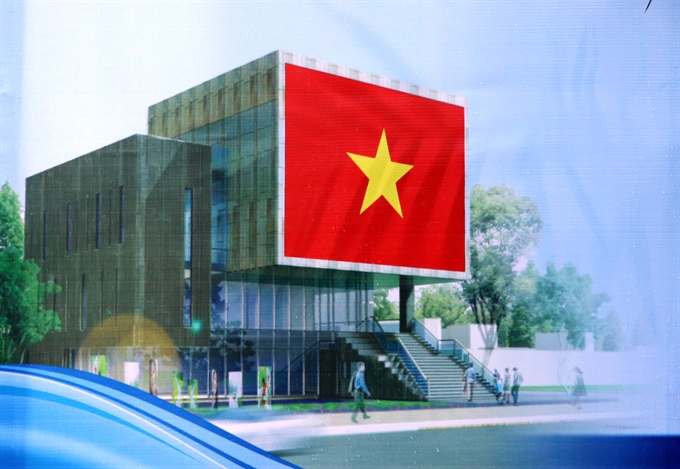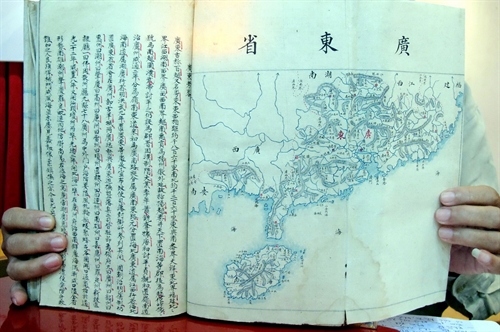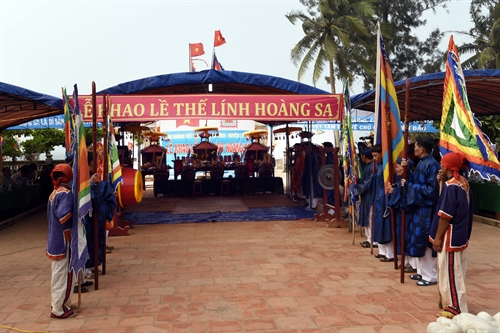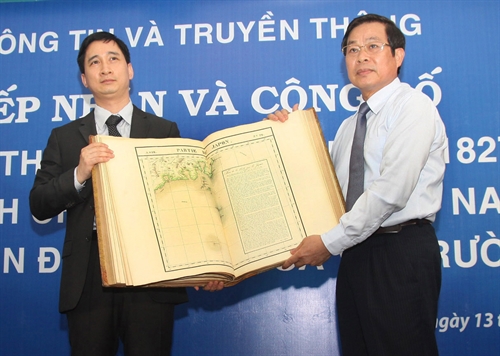 Features
Features

January 19, 2017, will recognise the 43-year anniversary of the date when China occupied and took Hoàng Sa (Paracel) islands from the hands of Vietnamese soldiers, who served the Republic of Việt Nam’s navy, as prisoners.
 |
| Memorial hall: A model of the Hoàng Sa Museum is under construction. Inspired by a royal seal in 1835, the museum stresses Việt Nam’s sovereignty over the Paracel islands. — VNA/VNS Photo Trần Lê Lâm |
By Bùi Hòai Nam in Đà Nẵng, with additional reporting by Mỹ Hà in Hà Nội
The central city of Đà Nẵng’s Historical Association has called on the public to donate memorabilia and documents for the Hoàng Sa (Paracel) Museum from July until January 19, 2017.
January 19, 2017, will recognise the 43-year anniversary of the date when China occupied and took Hoàng Sa (Paracel) islands from the hands of Vietnamese soldiers, who served the Republic of Việt Nam’s navy, as prisoners.
The Hoàng Sa (Paracel) Museum, which has been built on an area of 1,300sq.m along Hoàng Sa Street, will accommodate artefacts, memorabilia, documents, ancient maps on Việt Nam’s sovereignty over the Hoàng Sa (Paracel) and Trường Sa (Spratly) archipelagoes.
The city has planned on 128,543ha for development of Hoàng Sa district, including the Hoàng Sa (Paracel) islands, following the Prime Minister’s decision on the city’s adjusted master urban plan for 2030 and 2050.
The Hoàng Sa District’s people’s committee proposes to include two fishing precincts Thọ Quang and Mân Thái in the administration of Hoàng Sa Island District.
The museum building was inspired by the design of a royal seal from the Nguyễn dynasty’s King Minh Mạng in 1835 for establishing the Hoàng Sa Flotilla to administer the islands.
The seal justifies Việt Nam’s sovereignty over the Hoàng Sa and Trường Sa archipelagos as per ancient documents from previous centuries.
During the process of gathering evidences for the Hoàng Sa Museum, Chairman of Đà Nẵng Historical Association Bùi Văn Tiếng said all documents, photos, maps and antiquities related to Việt Nam’s sovereignty over Hoàng Sa (Paracel) and Trường Sa (Spratly) archipelagos will be displayed at the museum when it completes construction later this year.
“We have collected over 150 maps, books and document published by domestic and foreign publishers between 1618-1859, and 1626-1908 indicating Hoàng Sa (Paracels) and Trường Sa (Spratlys) as part of Việt Nam,” Tiếng said.
 |
| It’s in writing: An ancient map book "Địa dư đồ khảo", geography annals under China’s Emperor Te Tsung, collected by scholar Trần Đình Sơn, shows that "the southernmost border of China stays at Hainan Island." — VNA/VNS Thế Anh |
“The collection, which has been donated by local and overseas Vietnamese, includes two books of Postal Atlas Maps of China which were published by the Directorate General of Posts of the Ministry of Transportation of the Republic of China in 1919 (consisting of 49 maps) and in 1933 (29 maps), as well as one Atlas of the Chinese Empire, published by the China Inland Mission in 1909 (23 maps). None of the three books list Paracels and Spratlys index pages,” he said.
Tiếng also said all documents and maps only clearly indicated that the southernmost point of China is the Hainan Island and that Paracels and the Spratlys belong to Việt Nam.
Đà Nẵng City’s Communication and Education Board also donated a map printed in 1969 stating that the Hoàng Sa Island Commune (or former Định Hải Commune) was merged into Hòa Long Commune of Hòa Vang District in Đà Nẵng.
Trần Đức Anh Sơn, vice director of Đà Nẵng City’s Institute for Socio-Economic Development, also suggested to the collecting team that an atlas (Atlas von China), published by German publisher Verlag von Dietrich Reimer, in 1885, confirming that the Paracels, and the Spratlys belong to Việt Nam’s sovereignty.
The atlas is stored at Havard University, in the US.
Sơn said he spent 10 months researching and collecting document related to Việt Nam’s sovereignty over Hoàng Sa and Trường Sa Islands at Havard University in the US.
"As a scholar, I made suggestions to the museum board about the atlas," Trần Đức Anh Sơn told Việt Nam News Sunday. "If the Hòang Sa Museum decides to display the maps as part of the exhibition, they need to contact Harvard University Library for public use of copyrighted material."
In May, a collection of 40 ancient maps, indicating the Paracels belongs to Việt Nam, and two atlases were displayed for the first time at a conference: Conflict in the South China Sea (called East Sea by Việt Nam) at Yale University in Connecticut, the US.
The maps were collected by Trần Thắng, an American of Vietnamese origin, and is president of the Institute for Vietnamese Culture and Education, in New York.
Thắng said that it was the first time that the ancient maps, which were published in 1618-1859 by the UK, the US, France, Germany and Scotland (1826 and 1980), and China, were exhibited in the US.
He donated a 150-map collection to Đà Nẵng City’s Institute for Socio-Economic Development in 2012.
Thắng said 20 maps published by Việt Nam and western countries (1618-1859) showed that the Paracels belongs to Việt Nam.
Twenty maps published by western countries (1826 and 1980) indicated that the southern frontier of China is Hainan island.
 |
| Public interest: An exhibition held in Thanh Hóa Province that features 120 documents confirming Việt Nam’s rule over the Paracels and Spratlys in the East Sea for centuries. Students of Hồng Đức University took their time to visit the display. — VNA/VNS Photo Ninh Đức Phương |
Việt Nam News Sunday interviews Bùi Kiến Thành, who was born and lived in the south till the 1960s. A graduate in economics from Columbia University in New York City in 1954, Thành was invited by the government of unified Việt Nam in the 1990s to return and live in his homeland, while providing consultancy to the top leadership.
“In 1960, I went to Pattle (Hoàng Sa) Island with Mai Văn Hàm, a prominent businessman in Sài Gòn, to check out the guano potential for commercial use,” Thành, now 85, told Việt Nam News Sunday on the phone, while on a work trip in Đồng Tháp Province in Việt Nam’s deep south.
“We left Đà Nẵng on a navy ship during the day and arrived also during the day. We were not seasick, though some others were. The sea was calm, no large waves.”
Thành said from the boat, he saw the island as a white rim made of coral reefs and green foliage on top of it. On the island were a military outpost of the South Vietnamese navy and a meteorological bureau, built by the French government, from where weather information was sent inland daily.
Thành was neither an official of the met office nor a navy officer, but a board member of the then Việt Nam Fertiliser Company. They went to explore if their company could exploit guano for commercial use.
“We visited the site where guano was already been exploited by another company. The thickness ranged from 50cm up to more than 1m in depth. From the area we examined, thousands of tonnes could be collected for agricultural use,” he said.
Guano, or seabirds’ excrement that has piled up over many thousand years, is exceptionally rich in nitrogen, phosphate and potassium, which are key nutrients for plant growth and the rice production.
 |
| Soldiers remembered: The annual ceremony to remember soldiers who did not come back is performed by people on Lý Sơn Island. Numerous graves are dedicated to the deceased soldiers. — VNA/VNS Photo Nguyễn Đăng Lâm |
According to Wikipedia, “The 19th century guano trade played a pivotal role in the development of modern input-intensive farming practices and inspired the formal human colonisation of remote bird islands in many parts of the world.
“During the twentieth century, guano-producing birds became an important target of conservation programmes and influenced the development of environmental consciousness. Today, guano is increasingly sought by organic farmers.”
Many years have passed and Thành said he did not remember the statistics. But he still recalls the crystal clear water on Pattle (Hoàng Sa) coral reef sea shore.
“I could see fish swimming and giant seashells, measuring 30cm by 40cm, like the holy water bowls in churches. At night, I looked up at the starry sky when a nice breeze embraced me. I was 29.”
While many historical documents have been collected so that future generations could know and treasure their predecessors’ work to maintain and protect Việt Nam’s sovereignty over the Paracels and Spratlys, personal memories like that of Thành and probably soldiers who served in the South Việt Nam navy can be convincing testimony of Việt Nam’s actual ownership and control up to January 19, 1974.
“We have received many documents,” Võ Ngọc Đồng, head of Đà Nẵng’s Department of External Affairs, said in an e-mail. His department is overseeing the building of the future museum.
“We know there are more documents being preserved in the wider population. We encourage their owners to send and share those documents as well as memories with the people.”
 |
| For the record: Minister of Information and Communications Nguyễn Bắc Son (right) receives the World Atlas printed in Brussels in 1827, pertaining to the East Sea. Mr. Ngô Trí Dũng, General Director of the Pharmaceutical company ECO sponsored the purchase of the atlas. — VNA/VNS Photo Hoàng Hùng |
The donation programme also received documents and letters related to Hoàng Sa Islands of Việt Nam before 1974 from Nguyễn Thị Lụa from southern Cần Thơ Province.
Lụa’s husband, who died for the protection of Hoàng Sa Island when China took the islands by force on January 19th, 1974, had sent letters and personal memorabilia in connection with life on the islands.
Lụa also named his son, who was born one month after his father died in 1974, under the name of Hoàng Sa Island.
The People’s Artist Chí Trung also donated a film titled – Nhớ Đảo (Hoàng Sa Island’s Nostalgia) – exploring the lives of residents who had lived before 1974.
The film was awarded a Gold Medal at the Việt Nam Film Festival, and the National Press Award in 2005.
The city’s historical association also called for more donations of ancient documents, books, maps and objects related to Hoàng Sa and Trường Sa among Vietnamese at home and abroad as well as international collectors. — VNS




